2018-11-27
Based on
Influences
https://www.seriouseats.com/2011/06/the-food-lab-the-science-of-no-knead-dough.html
Ingredients
| Ingredient | Weight (grams) | Baker’s Percentage |
|---|---|---|
| King Arthur Bread Flour | 900 | 100.0% |
| Filtered water | 540 | 60.0% |
| Kosher salt | 18.00 | 2.0% |
| Sourdough Starter * | 600 | 66.7% |
Makes 2 loaves.
* Ischia Island (Italy) sourdough starter at 100% hydration
Total hydration: (540+(600/2))/(900+(600/2)) = 70.0%
Process
Feed starter and allow to ferment at room temperature for 11 hours.
Mix all ingredients and stir with a spoon until combined (but do not knead).
Transfer to a container with top, cover, and allow to rise at room temperature for 13 hours.
Transfer to refrigerator and bulk ferment for 30 hours. Gently punch down the dough after 18 hours.
Remove dough from refrigerator and allow it to warm up at room temperature for one hour.
Preheat oven to 450 degrees Fahrenheit with a cast iron skillet on top of a baking stone on the bottom rack.
Flour work surface. Add lots of flour if needed to form a workable dough. Divide dough in two. Shape loaves into rounds, place back in oiled bowls and cover. Proof at 68 degrees for 35 minutes.
Transfer loaves from bowl to parchment paper. Flour the top of the loaves and score with a sharp knife at a 30 degree angle.
Place loaves and parchment paper in hot cast iron skillet, spray with filtered water, place top (an inverted stock pot works well) on skillet, and spray sides of oven with water. Close oven door immediately.
Lower temperature to 410 degrees Fahrenheit. Bake with top on the cast iron skillet for the first 20 minutes, then remove top and spray top of loaf and sides of oven again with filtered water. Close oven door immediately.
After internal temperature reaches 190 degrees Fahrenheit, bake for another 8 minutes.
Rest on a wire rack for at least an hour before cutting.
Notes
The internal temperature of the bread rose steadily until it hit 190 degrees Fahrenheit, then it stopped climbing altogether. The crust was a nice color and the bottom sounded hollow, so I took it out even though previous loaves have hit 193-194 internal temperature in the same oven with the same settings. Maybe this has to do with a difference in weather (specifically pressure)?
Oven spring was excellent–better than any loaf I’ve made before, and this loaf was made at 8750 feet of elevation. In fact, the oven spring was so good that it ripped right down the middle through the scoring.
Crust crackled vigorously for several minutes after removing it from the oven.
The crumb was a little tighter than expected for a high hydration no-knead bread. It made for excellent toast, but wasn’t quite as rustic as I’d like. It wasn’t gummy at all, nor was it particularly dry–pretty close to perfect.
Salt content was a little low.
Flavor was mildly sour, but not terribly rich.
Images
 Sourdough starter fully ripened
Sourdough starter fully ripened
 Dough after warm ferment
Dough after warm ferment
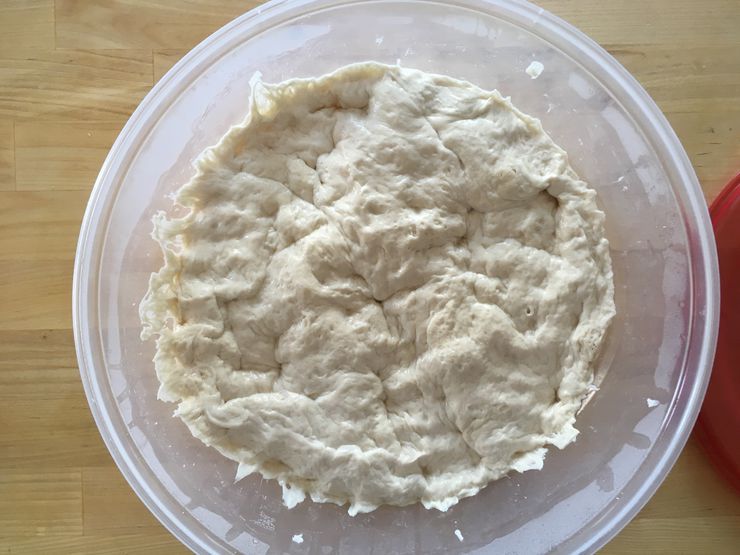 Dough during cold ferment
Dough during cold ferment
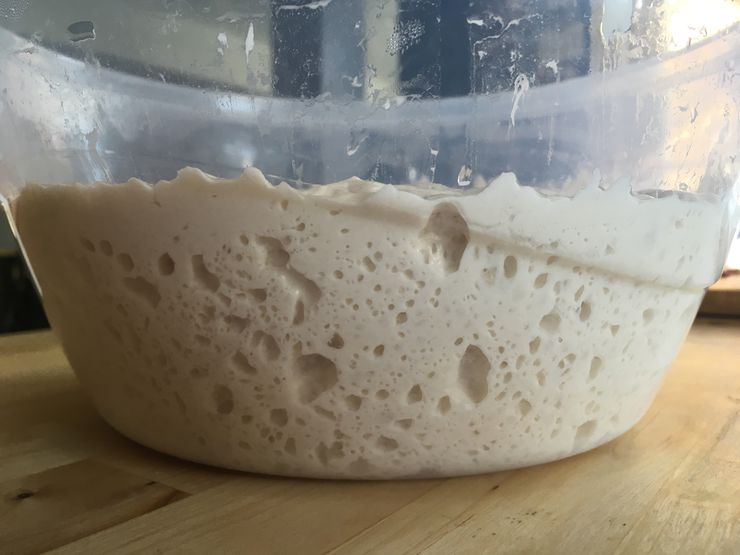 Dough during cold ferment
Dough during cold ferment
 Top of loaf
Top of loaf
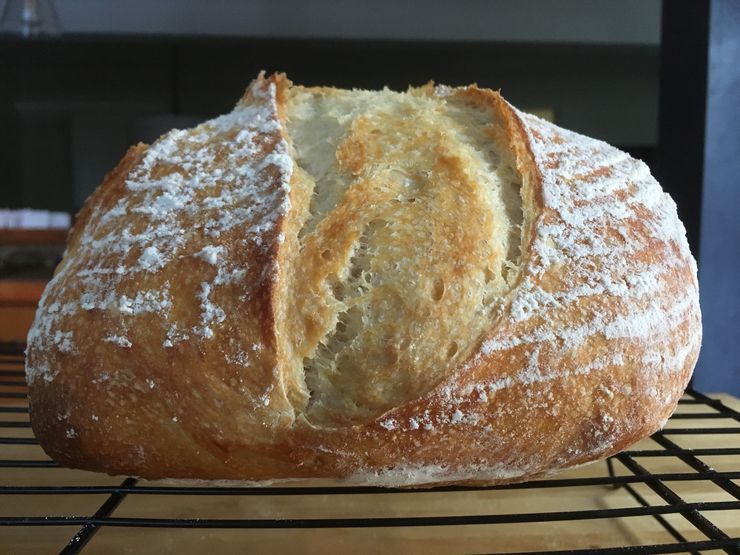 Side of loaf
Side of loaf
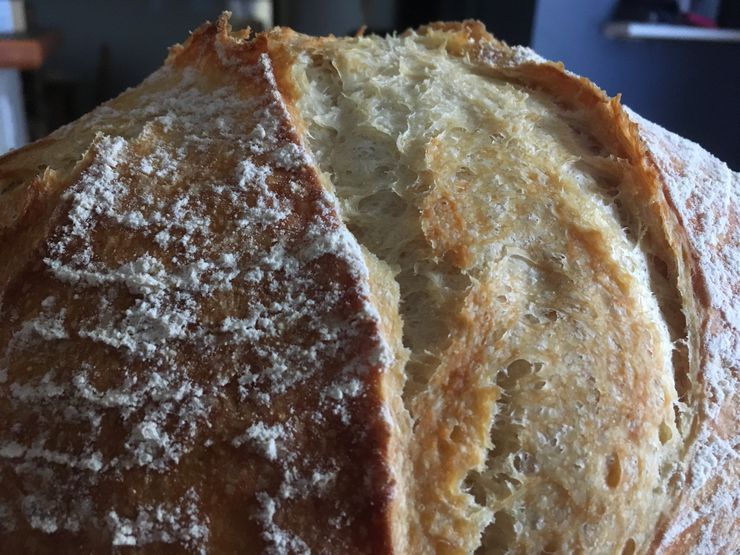 Crust and ears
Crust and ears
 It formed cracks after about an hour of resting
It formed cracks after about an hour of resting
 The overall loaf
The overall loaf
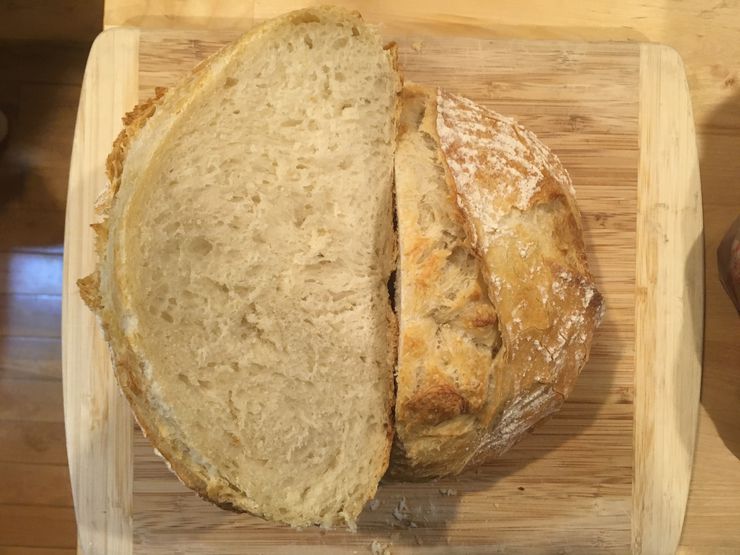 The crumb
The crumb
The crust crackling shortly after being removed from the oven (turn sound on)
Upcoming experiments
Score more deeply (or possibly using a different pattern) to prevent oven spring from splitting the loaf.
Flour the loaf generously before placing in the banneton, but don’t add additional flour after removing the loaf from the banneton (to improve the definition of the circular flour marks).
Add a little more salt.
Try fermenting in the refrigerator for longer to get more of a rich flavor.
Try using some all purpose flour to soften the crumb a bit.
Try baking in a real cast iron dutch oven.
Consider making the dough a bit drier for the bulk fermentation stage. Some articles mention that a drier starter makes a more sour bread. Might extend to the bulk fermentation phase as well. This bread was 70.0+% hydration during bulk ferment; maybe try to get below 68% (or lower) and see how it goes.